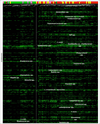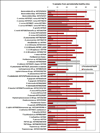Microbial signature profiles of periodontally healthy and diseased patients
- PMID: 25139407
- PMCID: PMC4213353
- DOI: 10.1111/jcpe.12302
Microbial signature profiles of periodontally healthy and diseased patients
Abstract
Aim: To determine microbial profiles that discriminate periodontal health from different forms of periodontal diseases.
Methods: Subgingival biofilm was obtained from patients with periodontal health (27), gingivitis (11), chronic periodontitis (35) and aggressive periodontitis (24), and analysed for the presence of >250 species/phylotypes using HOMIM. Microbial differences among groups were examined by Mann-Whitney U-test. Regression analyses were performed to determine microbial risk indicators of disease.
Results: Putative and potential new periodontal pathogens were more prevalent in subjects with periodontal diseases than periodontal health. Detection of Porphyromonas endodontalis/Porphyromonas spp. (OR 9.5 [1.2-73.1]) and Tannerella forsythia (OR 38.2 [3.2-450.6]), and absence of Neisseria polysaccharea (OR 0.004 [0-0.15]) and Prevotella denticola (OR 0.014 [0-0.49], p < 0.05) were risk indicators of periodontal disease. Presence of Aggregatibacter actinomycetemcomitans (OR 29.4 [3.4-176.5]), Cardiobacterium hominis (OR 14.9 [2.3-98.7]), Peptostreptococcaceae sp. (OR 35.9 [2.7-483.9]), P. alactolyticus (OR 31.3 [2.1-477.2]), and absence of Fretibacterium spp. (OR 0.024 [0.002-0.357]), Fusobacterium naviforme/Fusobacterium nucleatum ss vincentii (OR 0.015 [0.001-0.223]), Granulicatella adiacens/Granulicatella elegans (OR 0.013 [0.001-0.233], p < 0.05) were associated with aggressive periodontitis.
Conclusion: There were specific microbial signatures of the subgingival biofilm that were able to distinguish between microbiomes of periodontal health and diseases. Such profiles may be used to establish risk of disease.
Keywords: aggressive periodontitis; biofilm; chronic periodontitis; gingivitis; microarray analysis; microbiota.
© 2014 John Wiley & Sons A/S. Published by John Wiley & Sons Ltd.
Conflict of interest statement
Figures




References
-
- Armitage GC. Development of a classification system for periodontal diseases and conditions. Annals of Periodontology. 1999;4:1–6. - PubMed
-
- Armitage GC. Learned and unlearned concepts in periodontal diagnostics: a 50-year perspective. Periodontology 2000. 2013;62:20–36. - PubMed
-
- Armitage GC, Cullinan MP. Comparison of the clinical features of chronic and aggressive periodontitis. Periodontology 2000. 2010;53:12–27. - PubMed
Publication types
MeSH terms
Grants and funding
LinkOut - more resources
Full Text Sources
Other Literature Sources
Miscellaneous

